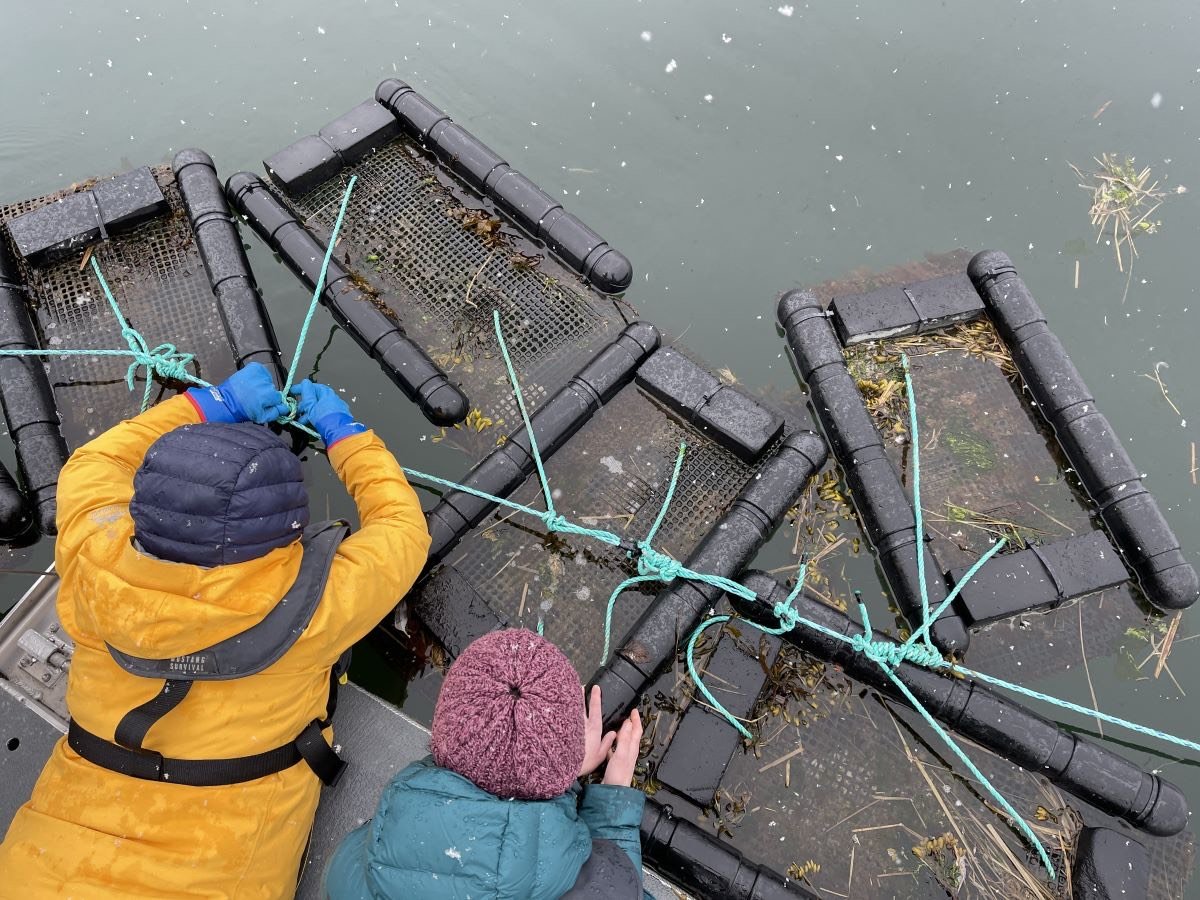PWSC Students Explore Local Science
Frank Schweers with his interactive map showing data from a database of Alutiiq Pride Marine Institute water samples. Photo courtesy of Frank Schweers.
By Allison Sayer
On April 30, Prince William Sound College (PWSC) held its second annual environmental sciences symposium. At the event, members of the public had the opportunity to learn about five students’ independent research projects from poster presentations and brief talks.
J.L. Chapin, who goes by “Chapin,” focused on microplastics in Prince William Sound. He obtained local shrimp and salmon, dissected the animals, and photographed visible microplastic filaments he saw under a microscope. He showed that animals we harvest right here do contain microplastics.
Chapin said the main motivation for his work was to spread awareness about the issue, and how it affects our local waters. Chapin plans to spend the summer working for a conservation organization removing plastic debris from beaches on Kayak Island. During Q&A, he discussed issues around plastics further with attendees.
Hannah Bogdan has been performing field work and lab analysis in collaboration with UAF postdoctoral students Natalie Monacci and Brian Philip Ulaski for three semesters. Her duties included traveling biweekly on a City of Valdez boat to Valdez Native Tribe (VNT)’s experimental oyster baskets to examine “fouling”- growth of non-oyster organisms- on the baskets. The site is located between Gold Creek and Shoup Bay. Lab analysis of species composition and other characteristics follows the field work.
Examining oyster baskets in the snow. Photo courtesy of Hannah Bogdan.
Bogdan stated that while too much fouling slows the oysters down, a moderate amount is positive because it provides them with food. This spring, her focus was on bringing other students out on the water and into the lab so the project will continue after her graduation this May. This summer, Bogdan will still be on the sound, and her work will include examining acidification at the oyster site.
Frank Schweers took a GIS class last year at PWSC and discovered he “really liked it.” The work he presented was a collaborative project with the Alutiiq Pride Marine Institute (APMI) using their database of several years of water sampling information. Schweers created an interactive map containing graphs and other visualizations of the data, making it possible for users to see groups of data at glance. New data will automatically be added to the map.
Schweers graduated with an associate’s degree in outdoor leadership this May, and will stay in the Copper Basin this summer working for NPS. He plans to pursue a bachelor’s degree at UAA next fall in geomatics.
Luke Stein, who hopes to go to law school in the future, Zoomed into the symposium from Sitka. He and a handful of other PWSC students were there participating in an aquaculture course. Stein’s interest was in the social and legal framework that would need to be in place for carbon storage programs utilizing kelp farms.
The Valdez Native Tribe experimental oyster farm. Photo courtesy of Hannah Bogdan.
Stein thoughtfully described the issues that would have to be addressed in a kelp-carbon storage future. These include a lack of standardization regarding how much kelp stores how much carbon, that potential projects would be located in public waters, and that not all communities would benefit equally from potential projects. He created a series of recommendations on permitting, equitability, and standardization.
Teag Panzer, who grew up deer hunting in Wisconsin, did a research project on white-tailed deer. There have been a handful of reports of white-tailed deer in Southeast Alaska. Wildlife managers are concerned they could infect local animal populations with ticks or chronic wasting disease.
Panzer discussed the amount of forage white-tailed deer consume, which could cause degradation of local habitat for resident species. He also wished to raise awareness and urged people to be on the lookout.
Hannah Bogdan with a sample. Photo courtesy of Hannah Bogdan.
Dr. Amanda Glazier, Assistant Professor of Biology and Environmental Science, organized the symposium. She emphasized that none of the students were required to do these projects to complete their certificate or degree program. Instead, they took an interest in the work and took it upon themselves to pursue it.
Students participating in the symposium are pursuing varied certificates or degrees, including the brand new Marine Natural Resources Technician certificate. The first cohort of students just finished up this semester-long program. There is currently funding available for students to participate in this program for free through 2026.
Much of the funding for the students’ work came from the Prince William Sound Regional Citizens’ Advisory Council (RCAC). Dr. Glazier announced that going forward, students will be eligible to receive funding from the Established Program to Stimulate Competitive Research (EPSCoR) through the University of Alaska Fairbanks.




